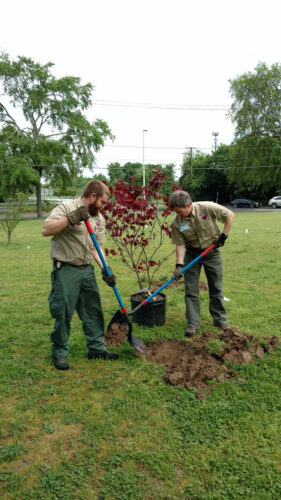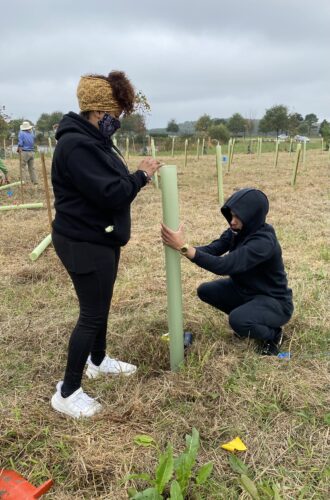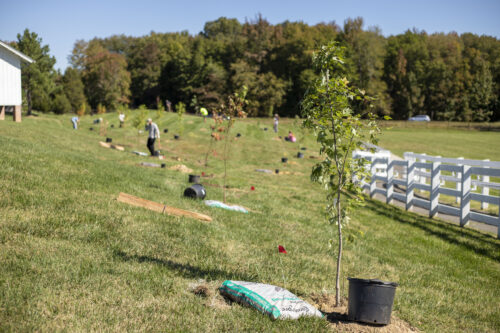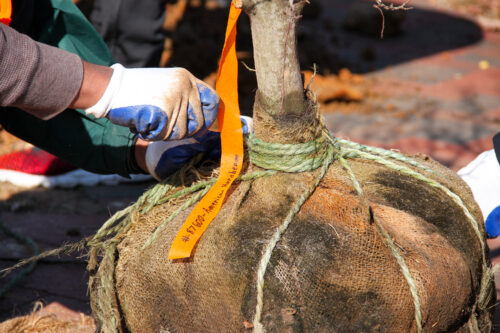
Tree Selection and Planting
Right Tree, Right Place
Many trees planted each year by well-meaning homeowners and community workers will never flourish because they are hopelessly unsuited for the conditions in which they are placed. Before rushing in to plant just any available trees, do enough research and planning to ensure success.
Factors to Consider
- Plant hardiness zone and heat tolerance
- Native plant species vs. non-native plant species
- Planting location and surroundings
- Microclimates
- Desired tree function
- Season of planting
Taking a bit of time to plan before putting a tree in the ground will save money and headaches in the future. When choosing a tree, make sure to do a complete site evaluation to understand the conditions and ensure the best tree for the site chosen.
When to Plant
It is best to plant while the trees are dormant in late fall, winter, or early spring.
Deciduous trees planted in the fall, after the heat of summer diminishes, have several months to re-establish their root system and often emerge healthier the next spring than those transplanted in the heat of summer.
Evergreens should only be planted in late winter or early spring – but beware of foliage drying and “winter burn”. Unlike deciduous trees, evergreens hold onto their foliage throughout the winter, and to keep them green they need a lot of moisture. Bright sun and harsh winds in the winter months can cause the needles to lose moisture, and plant roots cannot take up enough water from the soil in frozen ground, which can cause dry foliage and “winter burn”. In newly planted trees where the root system is already too small for the canopy, this problem is made worse.
Planting Different Types of Nursery Stock
Trees may be purchased as bare-root, container-grown, or balled and burlapped. Correct planting and initial maintenance are essential for a long, healthy life for your tree. The most common cause of poor tree health is poor planting: too deep, too shallow, or in too small an area. The objective is to plant the tree so that the root flare at the bottom of the trunk is at (or slightly above) the surrounding ground level.

 The most important thing to remember when choosing to plant bare-root trees is you must not let the roots dry out. Soak roots in water before, during and after planting to ensure good contact with the surrounding soil. Follow these steps for successful planting:
The most important thing to remember when choosing to plant bare-root trees is you must not let the roots dry out. Soak roots in water before, during and after planting to ensure good contact with the surrounding soil. Follow these steps for successful planting:
- Gently prune away any dry, damaged, and broken roots using a sharp tool.
- Dig a shallow planting hole no deeper than the roots will be when they are spread out.
- Make the hole wider than the root system to allow for spreading.
- When planting large bare-root stock, backfill with native soil while watering simultaneously, creating a slurry of mud to cover the roots.

Trees sold in containers are the most common type of stock found in nurseries. When moving a tree, always pick it up by the container and NOT by the trunk!
- Dig the planting hole the same depth as the tree is growing in the container. Caution: Sometimes growing medium surrounding the tree in the container is above the root flare and the excess should be removed.
- Make the planting hole at least two to three times wider than the container.
- Remove the tree from the container before planting.
- Container-grown trees may show circling roots that should be straightened out to prevent later girdling and to encourage natural root growth. Trees are constantly growing and shedding the fine absorbing roots that are lost in this process, and root pruning will stimulate new root growth.
- Place the tree in the planting hole and backfill with native soil.
- Use your boot to gently press on the backfill soil to ensure good root to soil contact.
- Water your newly planted tree.

Trees sold balled and burlapped are usually larger stock that instantly add impact to the area in which you are planting. They are quite heavy and require multiple hands to successfully plant them. When moving a tree, always pick it up by the root ball or binding strings and NOT by the trunk!
- Dig the planting hole the same depth as the root ball. Caution: Sometimes growing medium surrounding the tree in the burlap is above the root flare and the excess should be removed.
- Make the diameter of the planting hole at least two to three times wider than the root ball.
- Remove all or as much packaging – string, wire basket and burlap – from the root ball as practical before planting the tree. Note: Do not worry if this causes deterioration of the root ball. The soil in the root ball is there to protect the roots during shipping.
- Place the tree in the planting hole and backfill with native soil.
- Use your boot to gently press on the backfill soil to ensure good root to soil contact and to rid the soil of air pockets.
- Water your newly planted tree.
Additional Resources
- Learn more about plant hardiness zones.
- Read more about tree care.
- Read more about tree identification.
Contact Us
For more information or questions about urban tree planting, e-mail us or use our contact form.
For more information or questions about planting bare-root seedlings from our nurseries, e-mail us or use our contact form.
